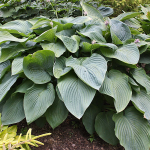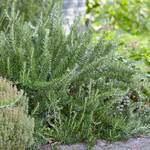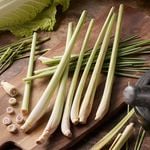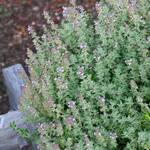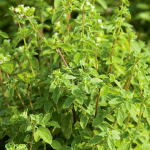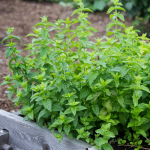Product Details
Are you new to gardening? Do you have a garden bed or elevated planter in full sun that you would like to transform into a kitchen garden full of fresh, flavorful, aromatic herbs? Our Start a Garden: Herb Garden for Cooks contains 5 different herb plants that thrive in the same conditions: 6+ hours of direct sun per day and well-drained soil. These plants were chosen by our horticultural experts to provide ease of care and delicious, fragrant additions to your favorite dishes. 1 plant of each variety listed below, 5 plants total. Covers approximately 12 sq ft. Planting diagram included.
- Basil ‘Caesar’ (Ocimum basilicum)
- French Thyme (Thymus vulgaris)
- Parsley (Petroselinum crispum)
- Sage (Salvia officinalis)
- Rosemary 'Arp' (Rosemarinus officinalis)
Before purchase, you’ll need to know your USDA Plant Hardiness Zone. This will determine which of the plants in this collection are hardy in your area and able to tolerate regional extremes of heat and cold. Click here to learn more about hardiness zones and to find yours. Here at the farm, we treat most of these herb plants as annuals, meaning we grow and enjoy them from spring to hard frost then pull them out, compost them, and re-order the following spring. The exceptions are the French Thyme and Parsley, both of which are hardy to Zone 4. We keep those in our kitchen garden and enjoy them for as long as possible, sometimes into the following year.
What can you expect?
The broad, tender, intensely aromatic green leaves of Basil ‘Caesar’ appear on an upright, relatively compact (15") plant and they keep coming from spring to summer (and on into fall if plants are pinched back or cut to remove seed heads). ‘Caesar’ is a terrific Basil for making pesto, Caprese salads, sauces and everything from lasagnas and other baked pastas to Eggplant or chicken Parmesan, tossed salads, and more. For a less traditional use, we love to snip stems for use as filler in flower bouquets, where the fragrance is an unexpected and delightful surprise.
Evergreen French Thyme (Thymus vulgaris) produces a low mound of semi-woody stems covered in tiny, gray-green leaves that pack more flavor and fragrance than you might think possible given their size. Thyme leaves are a favorite in chicken, egg, potato, and mushroom dishes, in soups, stews, and casseroles, and anything with goat cheese and/or peppers. Plants are evergreen and will winter over in the garden in Zones 4–9. Because of their low-growing habit, they are a great choice for the edge of the garden. In medieval France, Thyme plants were thought to be a home for fairies, and gardeners set aside a little bed of Thyme for them much as we provide feeders for hummingbirds.
Plenty of upright, branching stems tipped in tasty, vitamin-rich, deeply cut green leaves make Flat-leaf Parsley (Petroselinum crispum) a must-have in any herb garden and kitchen. The plants have a somewhat bushy form and should be snipped regularly to encourage the production of more leaves. The cut stems and leaves store well in the refrigerator and are also great for drying. Parsley leaves are a delicious, healthful addition to a wide variety of dishes from salads and soups to omelets, stews, casseroles, sautes, and steamed vegetables.
Velvety leaves in a shade of gray-green sprout from the erect stems of Culinary Sage (Salvia officinalis), creating a beautiful tonal and textural accent amid this garden’s abundance of green foliage. When harvested for cooking, fresh Sage leaves have a richer, more balanced flavor than dried. Sage is a classic addition to Thanksgiving stuffing and dishes featuring Butternut Squash. It’s also a superbly aromatic and flavorful enhancement combined with Tomatoes, Eggplants, and Beans. Sage plants produce a profusion of purple-blue flower spikes that add lovely color to the herb garden, increasing this plant’s ornamental value. Fans of dried flowers may cut and hang bunches of Sage in the kitchen to create a pleasing herbal ambiance.
The tall, iconic spikes of Rosemary (Rosmarinus officinalis 'Arp') bring a strong vertical accent and Mediterranean touch to any herb garden. The sturdy stems are densely crowded with gray-green, needle-like leaves that impart a one-of-a-kind lemon-Pine flavor and fragrance to a broad range of dishes. The small, lavender-colored flowers are edible, too. Mince raw leaves and add them to cocktail-time nut mixes or bake them into shortbread cookies. Grill cut stems alongside meats such as lamb or chicken and vegetables to release fragrance and flavor, and chop the leaves or use stems in stews, soups, and roasts. Those of you who live in temperate climates can enjoy this plant year-round in the garden.
Enjoy this garden of aromatic and delicious herbs. We hope you make many tasty dishes with them and that this experience marks the start of many great gardening adventures.
For more information on growing and care, click Growing Guide.
Shipping
HOW PLANTS ARE SHIPPED
The size of the plants we ship has been selected to reduce the shock of transplanting. For some, this means a large, bareroot crown. Others cannot travel bareroot or transplant best if grown in containers. We ship these perennials and annuals in 1 pint pots, except as noted. We must point out that many perennials will not bloom the first year after planting, but will the following year, amply rewarding your patience. We ship bulbs as dormant, bare bulbs, sometimes with some wood shavings or moss. Shrubs, Roses, vines, and other woody plants may be shipped bareroot or in pots. The size of the pot is noted in the quick facts for each item.
WHEN WE SHIP
We ship our bulbs and plants at the right time for planting in your area, except as noted, with orders dispatched on a first-come, first-served basis by climate zone. We also ship a wide range of containers and planters, tools, supplies, fertilizers, garden wear, garden decor items, as well as indoor decorations like wreaths and dried bouquets when available. Estimated dates for shipping are indicated in the green Shipping Details box for each item. Please supply a street address for delivery. Kindly contact us with two weeks notice, if you'll be away at the expected time of delivery.
OUR GUARANTEE
We guarantee to ship plants that are in prime condition for growing. If your order is damaged or fails to meet your expectations, we will cheerfully replace or refund it. Please contact our Customer Service Department at 1-800-503-9624 or email us at [email protected]. Please include your order number or customer number when contacting us.
Reviews
There are no reviews yet. Be first to Write a Review.
Growing guide
Welcome to the world of gardening & our Start a Garden series
Growing Your Start a Garden: Herb Garden for Cooks
Your Start a Garden: Herb Garden for Cooks contains 5 different herb plants that thrive in the same conditions: 6+ hours of direct sun per day and well-drained soil. These plants were chosen by our horticultural experts to provide ease of care and delicious, fragrant additions to your favorite dishes. The majority of plants in this garden are called “annuals” because they grow, set seed, and die in the same season. Others may survive year to year in more temperate parts of the country, but for simplicity’s sake, we choose to treat all of the plants in this collection as annuals. We grow and enjoy all of the herbs from spring to hard frost then pull them out, compost them, and re-order the following spring.
This guide includes the following sections:
- Knowing & Growing Your Plants
- Laying Out Your Garden
- Caring for Your Garden
- Companions
- Calendar of Care
- Basil ‘Caesar’ (Ocimum basilicum)
Basil is an easy-to-grow annual herb that likes a warm, sunny site with good air circulation, and some afternoon shade in the hottest regions. It is sensitive to frost and cold, so wait until the soil and air has warmed (night temperatures consistently above 50°F) to put your plant in the garden. Basil appreciates consistent moisture in average to rich, well-draining soil. Harvest by cutting off tip branches and then removing the leaves. Plants will flower during the growing season which can cause a decline in leaf production and flavor quality. Pinch off flower buds to keep your plant producing stems and leaves. Water when the top 1” of soil is dry. Tip branches with leaves can be harvested for use at any time. Feed monthly with a balanced fertilizer.
- French Thyme (Thymus vulgaris)
Thyme is easy to grow in full sun and well-drained soil that is on the dry side. It dislikes wet soil, which makes plants susceptible to root rot. Loose and sandy soils with particularly good drainage are best. Thyme is drought tolerant once established. Plants will begin to flower in the summer, and although attractive to bees, flowers can be cut back—cutting 1–2″ into the leaves—to keep plants compact and encourage new growth. In the West, prune plants at any time to keep them dense. In the South, plants may languish in summer heat and humidity—cut back any withered stems, and once weather cools you will see a flush of re-growth. Pruning also helps to prevent plants from becoming too woody. In the spring, prune away any stems compromised by winter weather (called “winterkill”) then feed plants lightly with a balanced fertilizer. Thyme is rarely troubled by pests or disease. English Thyme (T. vulgaris) is perennial in USDA hardiness Zones 4–9. If you garden in any of those zones, you may choose to let Thyme overwinter in the garden or do as we do and remove it at the end of the season and order a fresh plant in spring.
- Flat-leaf Parsley (Petroselinum crispum)
Parsley is a biennial—meaning it will grow leaves in the first year but will flower and set seed in the second year—but is usually grown as an annual. Choose a site in full sun or partial shade with average, consistently moist, well-drained soil. Water when the top 1” of soil is dry and feed monthly with a balanced fertilizer. Harvest regularly to keep plants producing more leaves. Parsley can be potted in fall and brought indoors for a supply of fresh leaves during the winter. It is not affected by any serious pests or diseases. It is hardy in USDA hardiness Zones 5-8. If you garden in any of those zones, you may choose to let Parsley overwinter in the garden or do as we do and remove it at the end of the season, bring it indoors or compost it, then order a fresh plant in spring.
- Culinary Sage (Salvia officinalis)
Culinary Sage is a perennial that is native to the Mediterranean coast where it thrives in hot, dry summers in thin, rocky soil. For this reason, it requires a well-draining spot in full sun that has dry to medium-moisture soil. Good drainage is especially important during the winter as wet soil can cause root rot. Check the soil regularly. If it is dry 1” deep, provide water. Plants benefit from a deep watering, perhaps once a week during the growing season, if there is no rainfall. Harvest leaves at any time and use them fresh or dry. Plants tend not to be long-lived, so plan to replace them every 3 or 4 years. Cut back your plant by half (or more) each spring to encourage full, bushy growth (this is not necessary when you are first planting this garden). Culinary Sage is largely untroubled by pests or disease. It is perennial in USDA hardiness Zones 6-8. If you garden in any of those zones, you may choose to let the Sage overwinter in the garden or do as we do and remove it at the end of the season, discard or compost it, then order a fresh plant in spring.
- Rosemary (Rosmarinus officinalis 'Arp,' also known as Salvia rosmarinus ‘Arp’)
Rosemary is a tender perennial in our growing area but is generally hardy in USDA hardiness Zones 6-10. Plants grow into 2- to 3-foot aromatic evergreen shrubs with thin, piney-scented gray-green leaves. Native to the Mediterranean, Rosemary needs a spot with full sun and good air circulation, and it must have excellent drainage, especially in winter. It does not do well in heavy clay soils. Water sparingly, allowing the soil to dry out slightly between waterings. In mild-winter areas, where the ground doesn't freeze, Rosemary can be planted in the garden. In cold winter areas with ground-freezing frosts, Rosemary is treated as an annual, or it can be potted and brought indoors during the cold weather. Rosemary rarely has problems with insects or diseases but it is susceptible to powdery mildew during humid summer months when air circulation is poor. Feed lightly once a year in spring.
To lay out your garden to best advantage, first see the Planting Plan that is included in your box. (You may also find it on the product page on our website. Search SKU #87527.) Keep in mind that you don’t have to position your Start a Garden: Herb Garden for Cooks plants exactly as we show them in the plan. Our diagram is just one possible design based on the heights, shapes, and compatibility of the plants. The mature height and recommended spacing for each plant can be found on the plant tag. (It’s best to keep these tags and put them in the ground alongside your plants. That way, you’ll remember which is which.) Your garden bed may have different dimensions or you might wish to tuck your plants into several different areas. Keep in mind that the Sage, Rosemary, and Thyme do best in very well-draining soil that tends to dry out slightly between waterings, so plant these herbs near one another. Basil and Parsley prefer a higher moisture level so can be planted on either side of the other plants, as shown, or next to one another.
Light: The plants in this collection all thrive in full sun, which is defined as 6+ hours of direct sunlight per day.
Watering: Immediately after you plant your new herbs, water them well to settle the soil around them. In the weeks and months that follow, providing them with their preferred level of hydration will be key to helping them thrive. Pay attention to how wet or dry the soil is – you don’t want to let the plants dry out entirely, but they will suffer if they are in constantly wet soil (the roots may rot). The soil around the Sage, Thyme, and Rosemary should be allowed to dry out slightly between waterings. The best way to assess the moisture level in your soil is to stick your finger in to a depth of 1”. If the soil feels moist, do not water. Wait until it feels somewhat dry. The general rule is that new plants need approximately 1” inch of water per week whether it’s supplied by Mother Nature, your garden hose, or a watering can. (Sage, Rosemary, and Thyme may need less.) If possible, avoid overhead irrigation. It is best practice to water plants at the soil level, which means wetting the ground around and between them but not spraying directly on or at them. Water sprayed on leaves can promote fungus and disease.
Fertilizer, Soil & pH: There is no need for fertilizer at the time of planting and doing so can even negatively impact a plant’s proper development. All of the plants prefer a sandy, well-drained loam and a pH from 6.0 to 7.0. Testing your garden soil’s pH is not a requirement (some of us here at the farm have never done it in our home gardens while others swear by it). To learn more about soil testing and how to go about it, click here.
Reflowering: Herbs are grown for their foliage, not their flowers. While you may choose to leave a few blossoms here and there for aesthetic reasons or to feed pollinators, it is best to remove most flowers when they begin to form. Removing blossoms encourages your plant to produce more edible leaves.
Pests/Diseases: The plants in this garden are generally free from disease and insect pests. Plants are most susceptible to disease when they are stressed, which can be eliminated by meeting their needs—sun, proper watering, and good drainage.
- Chives
Summer: Be sure plants are getting the water they require. If weather conditions are dry, monitor the soil for moisture (see above under Caring for Your Garden – Watering) and, if necessary, get out the hose or watering can. Basil and Parsley will need roughly 1” of water per week. The Rosemary, Sage, and Thyme may require less. Weed to remove unwanted plants that can crowd or take nutrients away from your plants. Harvest leaves from each plant and cut stems to shape, as desired. Remove flowerheads that form. If you have noticed your Thyme languishing due to excessive heat and humidity, cut it back and once weather cools you will see a flush of re-growth
End-of-Season Care: Once you are finished enjoying and harvesting the edible foliage of your herb plants, they can be removed and composted. You may choose to keep those that may overwinter in your area (see individual plant information above).
To learn more, see our Expert Resources for New Gardeners.
To see more herb plants, click here.
To download a PDF of our New Gardeners Handbook, click here.
To download a PDF of our Glossary of gardening words, click here.

